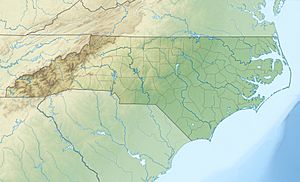Service Creek (Haw River tributary) facts for kids
Quick facts for kids Service Creek |
|
|---|---|
|
Location of Service Creek mouth
|
|
| Other name(s) | Tributary to Haw River |
| Country | United States |
| State | North Carolina |
| County | Alamance |
| Physical characteristics | |
| Main source | divide between Service Creek and Little Alamance Creek pond at Glen Raven, North Carolina 690 ft (210 m) 36°06′51″N 079°28′15″W / 36.11417°N 79.47083°W |
| River mouth | Haw River about 0.25 miles east of Burlington, North Carolina 499 ft (152 m) 36°06′32″N 079°23′35″W / 36.10889°N 79.39306°W |
| Length | 5.93 mi (9.54 km) |
| Basin features | |
| Progression | northeast then southeast |
| River system | Haw River |
| Basin size | 8.01 square miles (20.7 km2) |
| Tributaries |
|
| Bridges | Durham Street, Burch Bridge Road, Lakeside Avenue Ext, Glencoe Road, Lower Hopedale Road, Apple Street, North Graham-Hopedale Road, Squaw Valley Trail |
Service Creek is a small stream, about 5.93 mi (9.54 km) long, located in Alamance County, North Carolina. It flows into the Haw River, making it a "tributary." Think of it as a smaller helper stream that feeds into a bigger river.
Contents
The Journey of Service Creek
Service Creek begins its journey in a pond in a place called Glen Raven, which is also in Alamance County. From its starting point, the creek first flows towards the northeast.
Where Service Creek Ends
After flowing northeast for a bit, Service Creek makes a turn and starts flowing southeast. It continues this path until it reaches the Haw River. This meeting point is about 0.25 miles east of the city of Burlington, North Carolina.
Understanding the Service Creek Area
The land area that Service Creek drains is called its watershed. This watershed covers about 8.01 square miles (20.7 km2) of land. A watershed is like a giant bowl where all the rain and snow that falls eventually flows into the same stream or river.
Water and Land in the Watershed
Each year, the Service Creek watershed receives a good amount of rain, about 45.8 inches. This water helps keep the creek flowing. About 13% of the land in this area is covered by forests. These forests are important because they help filter the water and provide homes for wildlife.



